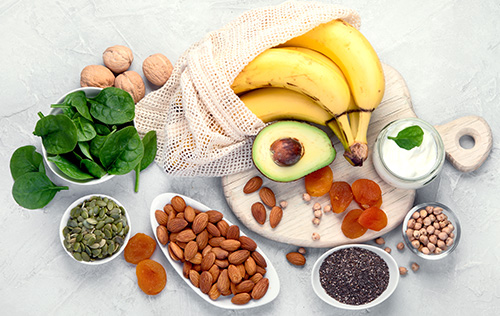The importance of potassium in your diet

This month's article is about the importance of potassium in your diet as discussed by the Center for Disease Control and Prevention (CDC), National Center for Chronic Disease Prevention and Health Promotion, and the Division for Heart Disease and Stroke Prevention.
The Role of Potassium and Sodium in Your Diet
Potassium and sodium are electrolytes that help your body maintain fluid and blood volume so it can function normally. However, consuming too little potassium and too much sodium can raise your blood pressure.
Though the words “salt” and “sodium” are often used interchangeably, they do not mean the same thing. Salt (also known as its chemical name, sodium chloride) is a crystal-like compound that is common in nature. Sodium is a mineral, and one of the chemical elements found in salt.
Potassium is found in vegetables, fruit, seafood, and dairy products. Most of the sodium Americans eat comes from packaged, processed, store-bought, and restaurant foods. Only a small amount comes from salt added during cooking or at the table.
Potassium, Sodium, and High Blood Pressure
Increasing your potassium intake can decrease your blood pressure if you have high blood pressure. Consuming too much sodium can raise your blood pressure. This means that, on average, the more sodium you consume, the higher your blood pressure will be, especially if you already have high blood pressure, also known as hypertension. Consuming too little potassium in your diet and too much sodium can raise your blood pressure.
Potassium, Sodium, and the Risk of Heart Disease and Stroke
Increasing potassium intake can reduce your risk of heart disease and stroke by lowering blood pressure. Consuming too little potassium and too much sodium can increase your risk of heart disease and stroke. Lowering blood pressure reduces your risk of heart disease and stroke.
Sources of potassium in food can come from apricots, sweet potatoes, spinach, potatoes, tomatoes, avocados, bananas, salmon, mushrooms, and beans.
Potassium in the Food Supply and Potassium Consumption
Most Americans do not consume enough potassium and consume too much sodium. The 2020–2025 Dietary Guidelines for Americans recommends that Americans include vegetables, fruits, dairy, and proteins as part of a healthy diet.
Good sources of potassium are found in each of these groups and are listed in the 2020-2025 Dietary Guidelines for Americans online. You can find potassium content and percent of daily values on the Nutrition Facts labels for packaged foods.
In late 2020, the U.S. Food and Drug Administration issued final guidance, Use of an Alternate Name for Potassium Chloride in Food Labeling, to allow food manufacturers to use the name “potassium salt” on food labels instead of “potassium chloride” to help people better understand that it is a salt substitute. Some manufacturers may use potassium chloride as a substitute for some salt in their products. Consumers may start seeing potassium salt on ingredient lists of food labels.